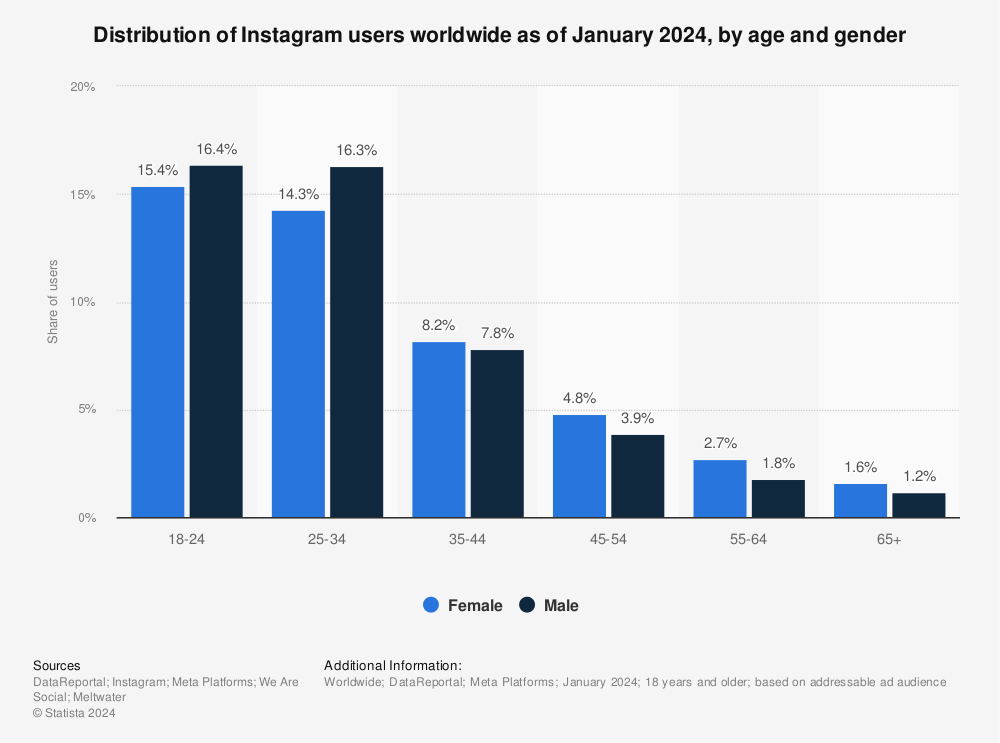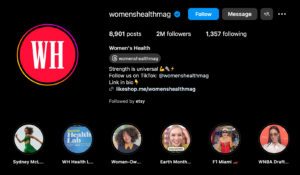There are many social media platforms for healthcare marketers to choose from. So, which one is right for meeting your brand objectives? In our new series, we dive into different platforms to consider, exploring how healthcare marketers can leverage these channels to connect with their audience and strengthen their online presence.
Keep reading to learn more about Instagram and the strategies that can elevate your healthcare brand!
What Healthcare Marketers Need To Know About Instagram
Instagram first launched in October 2010, the same year as Pinterest, and five years after Reddit and Facebook. In 2012, Instagram was acquired by Facebook (whose parent company is now Meta). With the acquisition, Instagram users saw an influx of new features, such as Facebook Messenger being integrated into Instagram DMs (direct messages), and other cross-platform capabilities.
Instagram is known for its visually-driven content, which originally focused on photos at launch, but has since broadened to include videos and a host of other features, like adding music to content, interactive stickers and polls, Instagram Notes, and much more.
Boasting over 2 billion monthly active users around the world as of April 2024, Instagram is the third most popular social media channel in the world, behind Facebook and YouTube. According to Statista, most of Instagram’s demographics fall into the 18-24 and 25-34 age groups, as illustrated in the chart below.

Source: Statista
Today, Instagram continues to update and innovate its platform, whether it’s exploring AI avatars or experimenting with other areas of the platform outside of traditional posts. While the platform used to be known for strong filters and photo editing, there’s been a shift in social media user preferences. Authenticity and “low/no-filter photos” help boost engagement by sharing content that is relatable. Instagram tends to be more casual compared to other channels like LinkedIn, and can be an effective part of a healthcare marketer’s digital marketing strategy.
Below, we share some Instagram features and strategies that support healthcare marketers with their digital marketing program!
Instagram Stories and Highlights
Stories are short clips of content that disappear after 24 hours. Their transient nature helps boost engagement as it taps into FOMO (“fear of missing out”), and encourages social media users to click on the Story so they don’t miss the update. When new Stories are shared, a page’s profile picture will feature a ring around it (example below).

While many people associate Stories with Instagram, this feature was actually created by Snapchat in 2013, with Instagram adopting it later in 2016. That being said, Stories quickly gained traction thanks to its large user base and broad appeal, becoming one of Instagram’s most popular features.
Originally, Instagram Stories were images or videos that lasted up to 15 seconds, though that has since increased to 60 seconds. Over the years, the company has continuously added new features to Stories, such as allowing users to share emoji sliders and other stickers, polls, and links. Compared to other features on the site, Story content tends to lean into the spur-of-the-moment, authentic type of posting.
How can healthcare marketers use Instagram Stories and Highlights?
1) Share timely updates that tap into users’ FOMO
For quick updates and other timely content, sharing it in a Story format drives engagement. After all, users don’t want to miss out on content that will disappear after 24 hours! For example, if your healthcare brand recently launched a new product, consider taking a photo of the product on store shelves and sharing it as a Story.
2) Pin informative Story content
Stories only stay up for 24 hours but if you create a Story Highlight, you can “save” your Story in an accessible folder that sits under the Instagram profile, as seen in the example above from Women’s Health Magazine. One of the most common (and useful) Story Highlights to create for a brand page is a Frequently Asked Question (FAQ) folder. Each Story can focus on one question and answer. Once you’ve assembled all of them into a Highlight, users just need to tap to cycle through all of the content you’ve shared. Other useful Story Highlights include About Us and Reviews or Testimonials.
3) Boost Story content
Over 500 million users access Instagram Stories daily, making it an effective way for healthcare marketers to reach their audience through both organic Stories and sponsored Story content. Instagram Stories can be “boosted” or sponsored, effectively turning them into ads. With the right targeting and optimization, these Story ads can reach your target audience, helping to increase brand awareness, website traffic, and lead generation.
Visual Content Matters On Instagram
Although Instagram has evolved significantly since 2010, it remains a visually-driven platform, setting it apart from platforms like LinkedIn and X (formerly Twitter), where text-based posts are more common. Every post on Instagram includes an image or video, making it an ideal channel for healthcare brands to showcase high-quality visuals, infographics, and videos.
Unlike TikTok where video is king—though it has been rumored that TikTok is exploring its own Instagram-inspired platform—Instagram is more flexible, offering users different formats to choose from. Carousels, which we’ll cover below, is one such example. Launched in 2017, carousels remain a popular way to garner a lot of engagement from Instagram users. As users swipe through the different photos and videos, they stay on one post for a longer period of time.
Video content is also a major component of Instagram, for better or worse. With the success of TikTok, there was a period when Instagram began to focus more on video, which led to backlash from users who felt photos were now being pushed to the side. That being said, the company has publicly stated they may have “gone too far into video.”
Ultimately, it comes down to this. Video continues to be an engaging format that’s not going anywhere. That said, photos still matter on Instagram. Instagram’s identity as a visual-first platform is here to stay.
How can healthcare marketers leverage Instagram’s focus on visuals?
1) Share video content on Instagram
As we covered in one of our previous articles, The Role of Video Marketing in Healthcare Education and Engagement, video can be an effective way for healthcare brands to simplify complex healthcare topics for their customers and patients. Instagram Reels, introduced in August 2020, were short 15-second videos that capitalized on what made TikTok so successful. Eventually, the company phased out its IGTV and all videos posted are now considered Reels.
2) Be authentic
One of the benefits of an omnichannel strategy is that it allows healthcare marketers to play to the strengths of the platforms they’re using. Compare Thornburg Investment Management’s LinkedIn or X account with its Instagram account — the latter focuses on employees, rather than thought leadership or educational content that users might see on X or LinkedIn. There’s more emphasis on people and less emphasis on text or polished graphics. For healthcare marketers, consider using Instagram as a platform to share behind-the-scenes content, spotlighting leaders and employees who are contributing to company growth. Volunteer initiatives and other charitable activities are also good topics to share on Instagram.
3) Make use of Instagram carousels
Why share just one photo when you can share many in a single post? Carousels allow users to swipe to view multiple photos, which makes this format an excellent choice for telling longer stories. We tend to see higher engagement with carousels compared to other formats like single images or video posts. Carousels can be an effective way to share educational healthcare content. Check out this example about contraceptive deserts from Nurx.
Is Instagram Right For Your Healthcare Marketing Brand?
Healthcare marketers, use Instagram if you…
1) Have access to a lot of photos or can create strong, quality visuals, whether it’s single images or videos
2) Have the capacity to create platform-specific content, such as Instagram Stories
3) Are open to using the platform for more casual purposes, such as employee or culture-related posts
Healthcare marketers, skip Instagram if you…
1) Want to focus more on thought leadership and written content (in which case, LinkedIn or X might be a better fit!)
2) Don’t have access to strong custom graphics capabilities
3) Know your ideal target audience for your healthcare product is on the older side
That being said, there are always nuances and it ultimately depends on the digital marketing goals you want to achieve. For example, consider Thornburg Investment Management. They share thought leadership content on their LinkedIn and more casual, culture-related content on their Instagram. This is an extra stream of work, but contributes to a stronger overall online presence. Their LinkedIn content might be attractive to potential clients, while their Instagram may attract potential talent interested in working at the firm. Here’s a healthcare example: Compare Baylor Scott & White Health’s LinkedIn and their Instagram and you’ll immediately see a difference in terms of the visuals used.
Stay tuned for future articles as we go through other major social media platforms, including LinkedIn, TikTok, and more!
In the meantime, if you’re unsure if Instagram is right for your brand, whether it’s in healthcare or another complex industry like finance, click the button below and schedule a one-on-one consultation with one of our digital marketing experts!


